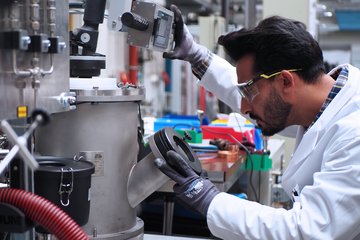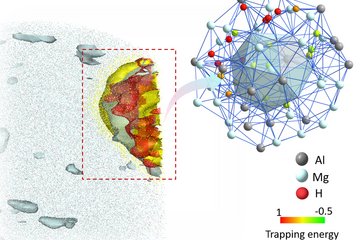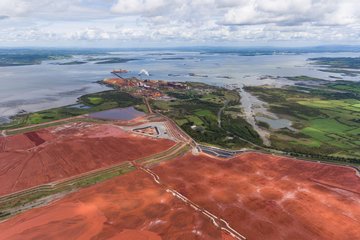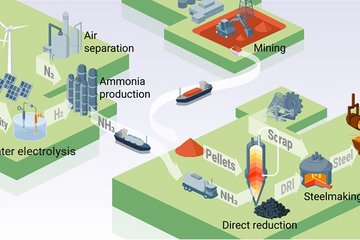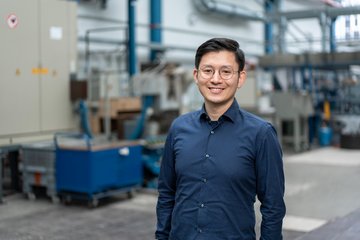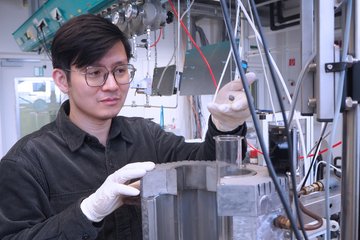Alle Typen
221.
Vortrag
Thermo mechanically coupled simulation of high manganese TRIP/TWIP steel. 27th International Workshop on Computational Materials
Modeling, IWCMM 27
, Leuven, Belgium (2017)
222.
Vortrag
An integrated crystal plasticity and phase field model to simulate twinning behavior in magnesium. Euromat 2017, Thessaloniki, Greece (2017)
223.
Vortrag
Interface damage modeling in an FFT framework. XIV International Conference on Computational Plasticity - COMPLAS 2017, Barcelona, Spain (2017)
224.
Vortrag
From ab-initio to macro: microchemistry dependent flow stress modeling based on first principle calculations. International Conference on Computational Plasticity (COMPLAS), Barcelona, Spain (2017)
225.
Vortrag
On the importance of using 3D microstructures in Crystal Plasticity Simulations. Symposium: 3D materials characterization at all length scales and its applications to iron and steel, Düsseldorf, Germany (2017)
226.
Vortrag
Strain Partitioning in Metallic Microstructures: The Importance of Considering the 3D Morphology. BSSM's 12th International Conference on Advances in Experimental Mechanics, University of Sheffield, Sheffield, UK (2017)
227.
Vortrag
DAMASK - Düsseldorf Advanced Material Simulation Kit. 7th MaDIS open seminar, National Institute for Materials Science, Tsukuba, Japan (2017)
228.
Vortrag
Modeling of interfacial damage in FFT solvers. 14th U.S. National Congress for Computational Mechanics, Montreal, Canada (2017)
229.
Vortrag
An integrated approach on microstructure, damage and texture modelling of modern steels. 5th International Conference on Steels in Cars and Trucks, SCT 2017
, Amsterdam, The Netherlands (2017)
230.
Vortrag
An integrated crystal plasticity-phase field approach to locally predict twin formation in magnesium. DGM Meeting, "Herausforderungen bei der skalenübergreifenden Modellierung von Werkstoffen ", Regensburg, Germany (2017)
231.
Vortrag
Thermo mechanically coupled simulation of high manganese TRIP/TWIP Steel. 5th International Conference on Material Modeling, ICMM 5, Rome, Italy (2017)
232.
Vortrag
Crystal Plasticity Simulations on Real Data: Towards Highly Resolved 3D Microstructures. MRS Spring Meeting 2017, Phoenix, Arizona, USA (2017)
233.
Vortrag
Predicting Materials Strength in BCC Alloys using parameter-less mesoscale approaches. MRS Spring Meeting 2017, Phoenix, AZ, USA (2017)
234.
Vortrag
Development of dislocation density based constitutive models ? the parameter dilemma. GAMM 2017, 88th Annual Meeting of the International Association of Applied Mathematics and Mechanics
, Weimar, Germany (2017)
235.
Vortrag
Coupling Phase-Field and Crystal-Plasticity Simulations. Plasticity 2017, 23rd International Conference on Plasticity, Damage & Fracture 2017, Puerto Vallarta, Mexico (2017)
236.
Vortrag
DAMASK - the Düsseldorf Advanced Material Simulation Kit Engineering of Advanced Materials. "Engineering of Advanced Materials: Numerische Optimierung basierend auf Vorhersagemodellen" Meeting, Erlangen, Germany (2016)
237.
Vortrag
From Phenomenological Descriptions to Physics-based Constitutive Models EPSRC Workshop on Multiscale Mechanics of Deformation and Failure in Materials. EPSRC Workshop on Multiscale Mechanics of Deformation and Failure in Materials
, Aberdeen, Scotland (2016)
238.
Vortrag
From micromechanics to component scale behavior. DGM AK Mikrostrukturmechanik, Aachen, Germany (2016)
239.
Vortrag
Von der Mikromechanik zum Bauteilverhalten. Trend-Workshop Dualphasenstahl, Bochum, Germany (2016)
240.
Vortrag
Crystal plasticity study of monocrystalline stochastic honeycombs under in-plane compression. 8th International Conference on Multiscale Materials Modeling, MMM2016, Dijon, France (2016)
